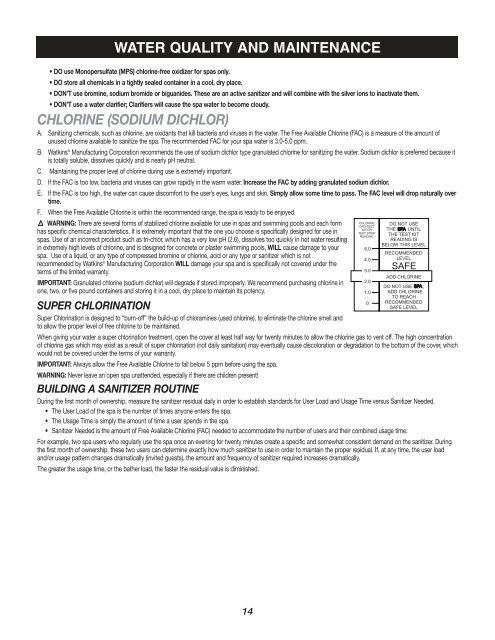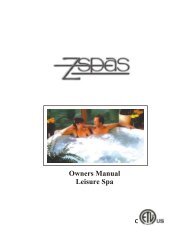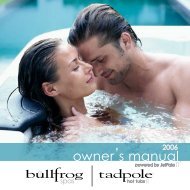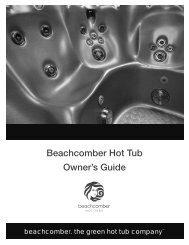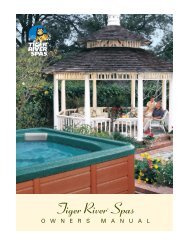Owner’s Manual
2006-2007 Oasis Series Owner's Manual - The Spa & Sauna Co
2006-2007 Oasis Series Owner's Manual - The Spa & Sauna Co
- No tags were found...
You also want an ePaper? Increase the reach of your titles
YUMPU automatically turns print PDFs into web optimized ePapers that Google loves.
WATER QUALITY AND MAINTENANCE<br />
• DO use Monopersulfate (MPS) chlorine-free oxidizer for spas only.<br />
• DO store all chemicals in a tightly sealed container in a cool, dry place.<br />
• DON’T use bromine, sodium bromide or biguanides. These are an active sanitizer and will combine with the silver ions to inactivate them.<br />
• DON’T use a water clarifier; Clarifiers will cause the spa water to become cloudy.<br />
CHLORINE (SODIUM DICHLOR)<br />
A. Sanitizing chemicals, such as chlorine, are oxidants that kill bacteria and viruses in the water. The Free Available Chlorine (FAC) is a measure of the amount of<br />
unused chlorine available to sanitize the spa. The recommended FAC for your spa water is 3.0-5.0 ppm.<br />
B. Watkins ® Manufacturing Corporation recommends the use of sodium dichlor type granulated chlorine for sanitizing the water. Sodium dichlor is preferred because it<br />
is totally soluble, dissolves quickly and is nearly pH neutral.<br />
C. Maintaining the proper level of chlorine during use is extremely important.<br />
D. If the FAC is too low, bacteria and viruses can grow rapidly in the warm water. Increase the FAC by adding granulated sodium dichlor.<br />
E. If the FAC is too high, the water can cause discomfort to the user’s eyes, lungs and skin. Simply allow some time to pass. The FAC level will drop naturally over<br />
time.<br />
F. When the Free Available Chlorine is within the recommended range, the spa is ready to be enjoyed.<br />
WARNING: There are several forms of stabilized chlorine available for use in spas and swimming pools and each form<br />
has specific chemical characteristics. It is extremely important that the one you choose is specifically designed for use in<br />
spas. Use of an incorrect product such as tri-chlor, which has a very low pH (2.6), dissolves too quickly in hot water resulting<br />
in extremely high levels of chlorine, and is designed for concrete or plaster swimming pools, WILL cause damage to your<br />
spa. Use of a liquid, or any type of compressed bromine or chlorine, acid or any type or sanitizer which is not<br />
recommended by Watkins ® Manufacturing Corporation WILL damage your spa and is specifically not covered under the<br />
terms of the limited warranty.<br />
IMPORTANT: Granulated chlorine (sodium dichlor) will degrade if stored improperly. We recommend purchasing chlorine in<br />
one, two, or five pound containers and storing it in a cool, dry place to maintain its potency.<br />
SUPER CHLORINATION<br />
Super Chlorination is designed to “burn-off” the build-up of chloramines (used chlorine), to eliminate the chlorine smell and<br />
to allow the proper level of free chlorine to be maintained.<br />
When giving your water a super chlorination treatment, open the cover at least half way for twenty minutes to allow the chlorine gas to vent off. The high concentration<br />
of chlorine gas which may exist as a result of super chlorination (not daily sanitation) may eventually cause discoloration or degradation to the bottom of the cover, which<br />
would not be covered under the terms of your warranty.<br />
IMPORTANT: Always allow the Free Available Chlorine to fall below 5 ppm before using the spa.<br />
WARNING: Never leave an open spa unattended, especially if there are children present!<br />
BUILDING A SANITIZER ROUTINE<br />
During the first month of ownership, measure the sanitizer residual daily in order to establish standards for User Load and Usage Time versus Sanitizer Needed.<br />
• The User Load of the spa is the number of times anyone enters the spa.<br />
• The Usage Time is simply the amount of time a user spends in the spa.<br />
• Sanitizer Needed is the amount of Free Available Chlorine (FAC) needed to accommodate the number of users and their combined usage time.<br />
For example, two spa users who regularly use the spa once an evening for twenty minutes create a specific and somewhat consistent demand on the sanitizer. During<br />
the first month of ownership, these two users can determine exactly how much sanitizer to use in order to maintain the proper residual. If, at any time, the user load<br />
and/or usage pattern changes dramatically (invited guests), the amount and frequency of sanitizer required increases dramatically.<br />
The greater the usage time, or the bather load, the faster the residual value is diminished.<br />
14


